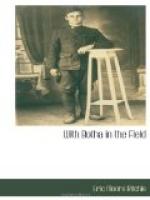When General Botha treks he treks at express speed. With him the intention is that the essence of strategy shall be surprise. The Commander-in-Chief left Swakopmund at 2.30 a.m. on the 18th of March. We outspanned at Goanikontes, thirty-four kilos, at 10.30 that night. Goanikontes was left at 6.30 a.m., and the Husab Outspan was made at 10.20 that morning. The rest of the day was spent at Husab; at 6.30 in the evening the Commander-in-Chief, and with him General Brits, left for Riet, outspanned for a few hours and attacked the German position at Riet at dawn on the 20th. The general action which was fought on the Pforte-Jakalswater-Riet front on this day was conceivably the most important move of the campaign. It was essential that the water-holes should be secured.
[Illustration: Main Guard aboard—en route to hunt the Huns] [Illustration: On the Great Trek—the Chief of the Staff has a hair-cut]
[Illustration: Action at Riet]
Around Riet, the principal point of attack and defence, the disposition of the Germans was as strong as it is possible to imagine. My sketch of the place should give a fair idea of things. In the technical sense it is not a true plan; but accuracy is not sacrificed to clearness. The veld around the Riet water-holes is just a mass of small kopjes and rocks; it narrows to a small defile that opens suddenly on to the coverless Husab Road. This defile is the only main approach to the Riet wells, and it is commanded close up on both flanks—on the right by the great bare kopje, Langer Heinreich, on the other by small kopjes and a line of ridges.
In attacking this position General Botha had to consider not only the enemy’s strength of position, but also the fact that his troops had to go into action after a waterless twenty-odd mile trek over the desert. As the Commander-in-Chief got up to his front on the 20th the big guns had started. The artillery duel continued well into the afternoon. Every credit is due to the other units, but it was our artillery that cracked the nut at Riet. The range was 2,700 yards; but the Germans never got it. Why it is difficult to say; they had every advantage, and one understands that the Germans are nothing if not artillerists. But they were a wash-out at Riet; they were over-firing the whole time. On the other hand, the Union gunners got the range at once and were all over the enemy. They put an ammunition wagon out of action after three shots, and did further deadly work. That afternoon General Botha sent a detachment out to attempt an enveloping movement. But they came back later, reporting that the slopes of Langer Heinreich on the right and the sharp kopjes on the left made the thing impossible.
As the afternoon came on I may say I don’t think we knew too much about the state of affairs with the enemy, and when he ceased artillery fire about 3.30 p.m. everyone seemed pleased enough. Few knew then that the German Commander had begun to evacuate the position; his supply of shells was said to have run short. On account of our numbers, also, he feared an enfilading movement on his left flank should our mounted infantry advance to the defile Q.




